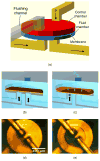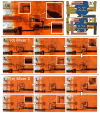High density 3D printed microfluidic valves, pumps, and multiplexers
- PMID: 27242064
- PMCID: PMC4917409
- DOI: 10.1039/c6lc00565a
High density 3D printed microfluidic valves, pumps, and multiplexers
Abstract
In this paper we demonstrate that 3D printing with a digital light processor stereolithographic (DLP-SLA) 3D printer can be used to create high density microfluidic devices with active components such as valves and pumps. Leveraging our previous work on optical formulation of inexpensive resins (RSC Adv., 2015, 5, 106621), we demonstrate valves with only 10% of the volume of our original 3D printed valves (Biomicrofluidics, 2015, 9, 016501), which were already the smallest that have been reported. Moreover, we show that incorporation of a thermal initiator in the resin formulation along with a post-print bake can dramatically improve the durability of 3D printed valves up to 1 million actuations. Using two valves and a valve-like displacement chamber (DC), we also create compact 3D printed pumps. With 5-phase actuation and a 15 ms phase interval, we obtain pump flow rates as high as 40 μL min(-1). We also characterize maximum pump back pressure (i.e., maximum pressure the pump can work against), maximum flow rate (flow rate when there is zero back pressure), and flow rate as a function of the height of the pump outlet. We further demonstrate combining 5 valves and one DC to create a 3-to-2 multiplexer with integrated pump. In addition to serial multiplexing, we also show that the device can operate as a mixer. Importantly, we illustrate the rapid fabrication and test cycles that 3D printing makes possible by implementing a new multiplexer design to improve mixing, and fabricate and test it within one day.
Figures





References
-
- Ho CMB, Ng SH, Li KHH, Yoon YJ. Lab Chip. 2015;15:3627–3637. - PubMed
-
- Yazdi AA, Popma A, Wong W, Nguyen T, Pan Y, Xu J. Microfluid Nanofluid. 2016:1–18.
-
- Qin D, Xia Y, Whitesides GM. Adv Mater. 1996;8:917–919.
Publication types
MeSH terms
Grants and funding
LinkOut - more resources
Full Text Sources
Other Literature Sources
Miscellaneous

